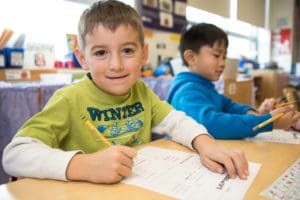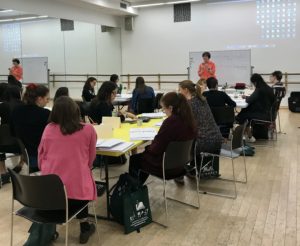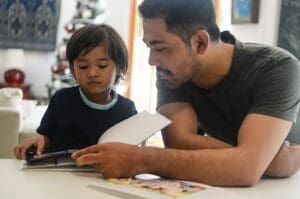by Sharon Pacuk
Preschool-aged children are naturally inquisitive about language and words. I still recall with delight my older son’s realization at four that to “bump into someone you know” meant to meet someone unexpectedly and not, as he had been trying out amongst his confused friends at school, gently hip checking them to get their attention. They are inordinately proud of “their letter” (the first letter of their name) and search for it on toy boxes and scribbled notes and text messages from grandparents. What they are doing is nothing short of code-breaking: The recognition that the squiggly lines plastered everywhere in their worlds are symbols called letters and these letters mean something! What an astounding first step into the world of reading.
And by first step, I mean a baby step. Because what preschool-aged children should not be doing is sitting down with words and being taught how to read them. Sure, there is the odd three-year old who snuggles into bed with the same set of Dr. Suess books each night and wakes up having taught themselves the sound-symbol relationship. These hyperlexic kids are the outliers; they are not the norm. Developmentally, most children are ready to learn to read at around 6 years old. (The National Early Reading Literacy Panel, convened in 2002 to study the best literacy practices for young children, defines the early literacy period as zero to five, or the end of kindergarten).
But teaching a child to read is not simply teaching them to decode words, just as building a house is not simply painting the walls and installing the fixtures. There is a foundation that needs to be built in both cases–slowly, steadily, and step-by-step–for the finished structure to stand on its own.
Research has shown us how to build a foundation of early literacy. The National Early Reading Literacy Panel outlined eleven variables that showed a moderate to large correlation to later literacy outcomes through a meta-analysis of approximately 500 research studies. These predictive variables included:
- Alphabet Knowledge: letter identification and sound-symbol knowledge
- Phonological Awareness: the ability to identify and manipulate the sounds of spoken language (including the ability to distinguish or segment words, syllables, and phonemes, or speech sounds)
- Oral Language: the ability to understand and use oral language, including vocabulary
- Visual Processing: the ability to discriminate and sequence visual symbols
- Concepts of Print: left-to-right tracking, understanding of cover, author, illustrator, etc.
These early literacy skills, among others such as the ability to write one’s name, form the foundation preschoolers need to become successful readers in elementary school and beyond. Ignoring these steps and skipping straight to decoding is akin to building a house without a floor. Below are some ways to build a strong foundation of early literacy for preschool-aged children.
Alphabet Knowledge
We have twenty-six letters in our alphabet, which means we have twenty-six individual tools with which to make the words of the English language. In order to learn sound-letter correspondence, young children first need to learn to recognize and name the letters of the alphabet.
Teach Alphabetic Order
While few children today will experience the sensory pleasures of flipping through a physical card catalog at the library, alphabetic order still matters. It is how we organize our files, our citations, our attendance lists, and the spices on our supermarket shelves. It is also how we ourselves are organized within so many of the public spaces and institutions we pass through in our lives. Teaching young students to sequence the letters of the alphabet not only helps cement letter identification, but it helps them learn to sequence–an essential language and literacy skill. Without an understanding of before and after, young students would be stymied by everything from lining up to go to recess to describing what they did over the weekend to retelling a story read aloud by their teacher.
Phonological Awareness
According to research on early literacy, phonological awareness–an umbrella term referring to the ability to identify, analyze, and manipulate the sound system of our language–is the strongest predictor of later reading success. In fact, the phonological system is so vital to reading that most researchers identify reading disorders as a direct result of the so-called phonological deficit (i.e., a difficulty with the representation of speech sounds).
Teach Rhyme Systematically
Rhyming, although relatively early in the typical sequence of phonological awareness skill development, can be difficult for some children. To build up to rhyme generation–where children are producing rhyming words themselves–take a step-by-step approach that starts with rhyme judgment (i.e., two pictures), moves to rhyme odd-one-out (i.e., three pictures–two that rhyme and one that does not), then to rhyme sorting, and, finally, when all of those prerequisite skills are in place, ending with rhyme generation. To further cue young children, you can have them not only listen for the same end sounds but to also pay attention to mouth feel. This strategy, outlined in the Intensive Phonological Awareness Program, gives multisensory support for children having difficulty recognizing or producing rhyme.
Oral Language
Oral language determines the way in which we navigate, mediate, and make sense of the world. In preschool, all learning rests on a foundation of oral language development. Young children need to develop oral language to describe what they see, explain what they are doing, learn and use new vocabulary, tell and retell stories, name their feelings and wants, mediate conflict, ask and answer questions, and navigate the routines of the classroom.
Teach Prepositional and Temporal Concepts
Prepositional and temporal words–e.g., first/next/last, beginning/middle/end, next to/behind/in front of–form the prerequisite language of phonological awareness. Before young children can tell us what sound they hear first or in the beginning of the word, they need to understand what first and beginning means.
To teach these important concepts, turn an Elkonin sound box (an evidence-based tool typically used to facilitate segmenting and blending of sounds during phonological awareness tasks) into a more all-purpose sequencing and segmenting tool by adding colors to the boxes. Make the first box green (the color of “go”), the second yellow (the color of “slow”), and the third red (the color of “stop”). Give students a toy car and have them drive into the “first” or “beginning” box, the “second” or “middle” box, and the “final” or “last” box. You can then have them sequence animal sounds using pictures (“Listen. Moo, baa, neigh. What animal came first?”), which helps set them up for identifying and sequencing letter sounds.
Visual Processing
The visual difference between letters is subtle. Note how a “t” turns into an “f” with a mere flick of the pencil. At the same time, letters (unlike pictures) change meaning based on position. A “p” can frustratingly turn into a “d” and then a “b” and then a “q” depending on the way it is facing.
Teach the Concept of Same vs. Different
I spent many an hour as a child in my pediatrician’s waiting room with old issues of Highlights magazine, scouting differences in the pictures they published in the back of each edition. Learning to visually discriminate similarities and differences remains a powerful way to prime young children to recognize the subtle visual differences of letters and patterns when reading.
Concepts of Print
Shared book reading helps develop early literacy skills before children are even verbal. According to the National Early Literacy panel, parents reading to their babies, toddlers, and preschool-age children significantly improves young children’s oral language and knowledge of concepts of print. To illustrate this point, the panel noted that an average child who was read to by an adult would score eleven points higher on a test of oral language than a child who was not read to.
Support Efforts to End Book Deserts
Despite the widely proven impact of early access to books on school readiness, background knowledge, vocabulary, and oral language development, access to books in vast parts of the United States is affected by structural inequalities. According to End Book Deserts, a non-profit organization that “advocates for children in high-poverty areas who lack basic access to age-appropriate books, high-quality reading materials, and book culture,” 45% of American children live in neighborhoods that lack access to public libraries or bookstores or live in homes that lack the resources to buy books for children. According to the US Department of Education, 61% of children living in low- income areas lack books in their homes. End Book Deserts has a number of resources for individuals looking to help make access to books and book culture a right and not a privilege for all children.
When we begin to see learning to read as a slow-and-steady climb rather than a sprint to the top, we are able to arm preschool children with the foundational literacy skills they need to become competent, confident, and successful readers.







